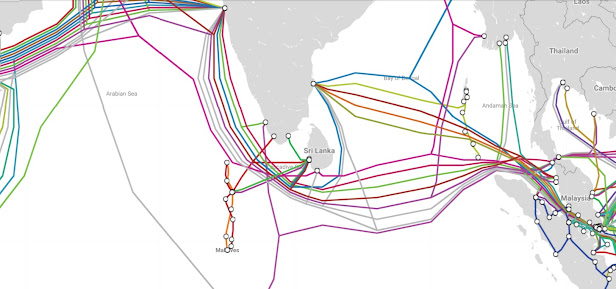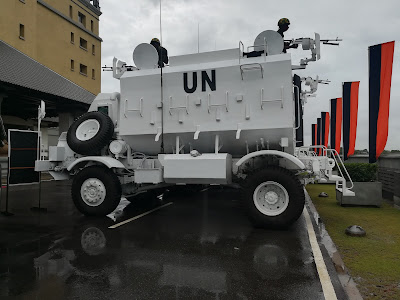Sri Lanka leads the region with a new framework to protect critical digital connectivity infrastructure
 |
| The network of undersea data cables which traverse around Sri Lankan territorial, EEZ waters and connect the country to the world. Pic - ICPC. |
By Asiri Fernando
Sri Lanka last week launched a Submarine Cable Protection and Resilience Framework (SCPRF), becoming the first nation in the region to initiate a process that will bring legislation on the seabed cable network that connects the island to the digital world of communication, services and commerce.
The SCPRF was launched at a stakeholder meeting chaired by Secretary to the President, Dr. P. B. Jayasundara on 15 July, the Foreign Ministry said. Foreign Secretary Admiral Professor Jayanath Colombage, senior ministry officials, members of the TRCSL, UNODC and the Japanese Embassy in Sri Lanka joined the launch.
The move by Sri Lanka, which is currently the Vice-Chair of the Indian Ocean Rim Association (IORA) gives the country the opportunity to take a lead role in a critical issue of global importance and be a more proactive global citizen.
According to the Foreign Ministry (FM), Sri Lanka is the first country in Asia to introduce such a framework which was drafted with support from the Government of Japan through the United Nations Office on Drugs and Crime (UNODC) – Global Maritime Crimes Programme (GMCP). New legislation and amendments are expected in the coming months.
The new legislation based on the framework is expected to encompass international best practices recommended by International Cable Protection Committee (ICPC). Incidentally, the ICPC also launched their Government Best Practices for Protecting and Promoting Resilience of Submarine Telecommunications Cables guide this month.
The Guide is aimed at assisting governments in developing laws, policies, and practices to foster the development and protection of submarine telecommunications cables, the infrastructure of the Internet.
The process of formulating the local framework began in September 2020, with stakeholder engagement and was followed by a series of virtual consultations, the Foreign Ministry said in a press release.
The development of the framework was undertaken jointly by the Telecommunication Regulatory Commission of Sri Lanka (TRCSL) and the Ocean Affairs, Environment and Climate Change Division of the Foreign Ministry with the technical assistance of ICPC and UNODC-GMCP.
Given Sri Lanka's trade and services hub ambitions and the increased reliance on digital connectivity due to the COVID-19 pandemic, building resilience and ensuring the protection of critical connectivity infrastructure is vital. The Director-General, Ocean Affairs Ms Hasanthi Dissanayake highlighted the necessity to declare Submarine Cables, also known as Undersea Data Cables (UDC), as ‘critical infrastructure’.
According to the UNODC, it is estimated that about US$ 10 trillion (2019 estimate) of economic activity moves through submarine cables every day. "99% of all international digital data and communications are transferred via a network of more than 400 cables, which span a distance of more than 1.8 million kilometres across the world’s oceans." the FM said.
Ten UDC lay on the sea bed within Sri Lanka's vast Exclusive Economic Zone (EEZ) with five cable landing stations along the coast, of which three are owned by telecom operators. With the world adjusting to the 'New Normal' of the post-COVID-19 future, the reliance on the UDC ecosystem will grow significantly. The ICPC estimates that internet traffic increased between 25% and 50% between November 2019 and the early stages of lockdown in April 2020. A trend that will likely increase.
The National Backbone Network (NBN) by Sri Lanka Telecom also relies on such UDC's and landing stations to keep Sri Lanka connected to the world. The lack of purpose-designed legislation to protect the cables, which are privately owned and maintained, from natural and man-made threats had long been a critical infrastructure vulnerability. Due to a majority of UDC's being privately owned, the cables do not fall under the sovereignty jurisdiction of countries beyond territorial waters.
“These cables come under Sri Lankan law only up to 12 nautical miles. However, at present beyond 12 Nm we have no legal authority to enforce their security or prosecute anyone who deliberately or negligently damage them” a Senior Navy officer told Defence Asia on terms of anonymity.
In 2017, Air Chief Marshal Sir Stuart Peach, the chief of the UK defence staff, told a NATO gathering that threats to the UDCs by state and non-state actors was a serious concern to the alliance and the national security of the UK.
Given the concerns regarding the impact of natural and man-made disruptions on global supply chains, the vulnerabilities of UDCs can no longer be ignored. Damage to a UDC servicing Somalia in 2017 by a container ship dragging its anchor caused a national internet outage for two weeks. The Somali Government estimated that the disruption caused US $ 10 Mn loss per day to the national economy. Sri Lanka was affected by similar incidents in 2004 and 2014.
"We are moving towards a paradigm shift in communication. As the digitalisation drive picks up and Sri Lanka become more reliant on digital connectivity, the protection of the sea bed cable ecosystem that are the backbone of global connectivity is as important as cybersecurity." Director-General TRCSL, Oshada Senanayake told Defence Asia.
Senanayake opined that the initiative will further strengthen the country's digital transformation. And help to improve Sri Lanka's standing as a hub for technology services and innovation.
“The National Framework would certainly consolidate Sri Lanka’s aspirations to develop into a Commercial and Financial Hub, as well as a Global Innovation Hub, as envisaged in the “Vistas of Prosperity and Splendor”. It was also noted that this initiative, “in close partnership with UNODC-GMCP, to develop the National Framework, would not only be seen as a major breakthrough for Sri Lanka but also for the whole region, to stand as a shining beacon in the Indian Ocean" Minister and Deputy Head of Mission at the Japanese Embassy in Colombo, Kitamura Toshihiro said at the launch of the Framework.
The need to bring UDC's under local jurisdiction was first highlighted in 2019 when the UNODC-GMCP convened a group of experts on the matter in Colombo following a request by the Government.


Hi, This is very nice content and more useful for readers. Hope you will post more content soon.
ReplyDeleteDefence Journalist